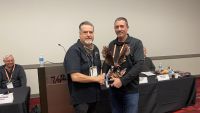Executive Director's Report
Total Masonry Construction Campaign
As you know, we have been a very close supportive partner in the Masonry Industry Executive Directors Council. Our initial project was to launch MasonrySystems.org and to conduct a $100,000 ad campaign directing architects, specifiers, school officials and public works officials to the "Systems" site. We have been successful, with daily hits averaging 3,000-5,000. During our last Execs Council Meeting, I challenged the Council to look beyond the initial success of the "Systems" campaign and to the think about developing a major national campaign to sell "Systems" that would rival the promotion done by the block, brick and stone industries. A small group of the execs council (Chairman Lynn Nash, Secretary Dave Gillick and Director Jim Jones, Ann Walters and I) traveled to Houston to meet with the Whole Wheat Creative ad agency to discuss developing a multi-million dollar campaign to sell Total Masonry Systems. We will be working with Whole Wheat Creative and
other Execs Council members to prepare a presentation that will be unveiled at the MCAA annual Meeting in Las Vegas. We hope that representatives of all contractor associations will be on hand (regardless of MCAA affiliation) to hear this far-reaching presentation.
Revision of the MCAA Masonry Training Series
As many of you know, the MCAA Masonry Training Series has received very high marks as being the best training manual in our industry. However, our manuals have not been reviewed or revised since they were published in 1996. I have asked Melissa Polivka to conduct a Masonry Training Series Review session with the assistance of the National Masonry Instructors Association. The review session was just held in Charlotte with five members of the NMIA. Since the MCAA Workforce Committee indicated that they did not have the funds in the budget to do this review the staff obtained sponsorship funding so we could conduct this very important session. Melissa has informed me that the two day review session went extremely well, resulting in many good ideas and revisions for a second edition of our manuals. We will be working to update and publish a second edition but not before the end of the fiscal year. We hope to have a second edition out by next fall.
Region VII OSHA Training Seminar
As a part of our MCAA/OSHA Alliance, the MCAA and MCA of St. Louis will be hosting a pilot program to train over 50 OSHA compliance officers and officials in Region VII on the best practices of the masonry industry. This pilot program will be held on November 17, 2005 in St. Louis, MO.
What we hope to achieve from this program is an opportunity for selected representatives of our industry to train OSHA Field Inspectors and officials on how we conduct our business, how we provide safety programs for our personnel, and why our industry has certain exemptions (such as overhand bricklaying, not using harnesses on scaffolding, why we can't clear materials off of scaffolding at the end of every shift and why we don't need to erect scaffolding on both sides of a block wall when grouting). OSHA will then have an opportunity to discuss with us what they look for in our industry with regards to safety. If the pilot works effectively, we will expand the program to all regions.
This will be an extremely effective program in minimizing interpretation among OSHA inspectors who cite contractors, causing us to have to expend tremendous resources fighting frivolous situations.
ICC's Final Action Code hearings in Detroit, Michigan
On September 29- October 2, 2005, the International Code Council held their final action hearings to determine what will be included in the 2006 versions of the I-Codes (IBC, IRC, IPC, etc.) The 2005 MSJC Code and Specification were adopted by reference into the 2006 IBC and IRC. There were three modifications made to the MSJC in its adoption (lap splice requirements, AAC masonry and veneer seismic detailing) that are discussed in the following in more detail.
Our Director of Engineering, Rashod R. Johnson, was one of a few industry professionals who testified against the amendment that would require longer lap splices in masonry construction. The ICC Committee agreed with our argument, and at least for the next three years or so, splice lengths should be more manageable. Lap splice lengths are expected to be reviewed in more detail in future standards and code hearings, so the battle is far from over.
Certification
Education Chairman David Hill headed up an MCAA Certification Task Force to look at the possibility and practicality of a national contractor certification program. The first information gathering meeting was held at the MCAA Midyear Meeting in Asheville, North Carolina. Twenty five members and staff participated in a two hour discussion on the possible benefits of developing a national contractor certification program. The group reviewed current and developing local association certification programs, strengths and weaknesses of a national program and the ability of the national association to implement such a program. The group unanimously approved the establishment of a small focused Task Force to research and make recommendations to the MCAA Board of Directors on the feasibility of moving forward toward developing a national certification program.
About the Author
Michael Adelizzi was the Executive Director of the Mason Contractors Association of America.


















